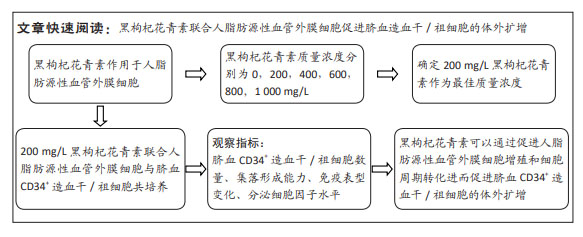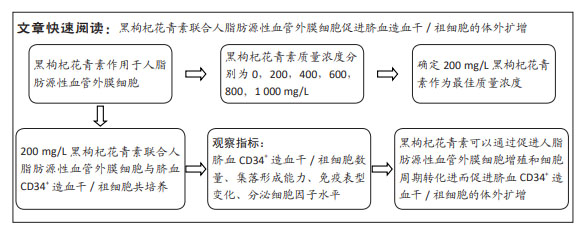中国组织工程研究 ›› 2025, Vol. 29 ›› Issue (1): 58-64.doi: 10.12307/2024.738
• 脂肪干细胞 adipose-derived stem cells • 上一篇 下一篇
黑枸杞花青素联合人脂肪源性血管外膜细胞支持脐血造血干/祖细胞的增殖
申娅媚1,2,牛云霞1,杨婷婷3,马 洁4,胡代宏4,郑 波4
- 1宁夏医科大学临床医学院,宁夏回族自治区银川市 750004;2宁夏回族自治区干细胞与再生医学重点实验室,宁夏回族自治区银川市 750004;宁夏医科大学总医院,3宁夏神经系统疾病诊疗工程技术研究中心,4血液内科,宁夏回族自治区银川市 750004
Anthocyanins from Lycium ruthenicum Murr combined with human adipose-derived pericytes/perivascular cells support proliferation of umbilical cord blood hematopoietic stem/progenitor cells
Shen Yamei1, 2, Niu Yunxia1, Yang Tingting3, Ma Jie4, Hu Daihong4, Zheng Bo4
- 1Clinical Medicine College, Ningxia Medical University, Yinchuan 750004, Ningxia Hui Autonomous Region, China; 2Ningxia Key Laboratory of Stem Cell and Regenerative Medicine, Yinchuan 750004, Ningxia Hui Autonomous Region, China; 3Diagnosis and Treatment Engineering Technology Research Center of Nervous Disease of Ningxia, 4Department of Hematology, General Hospital of Ningxia Medical University, Yinchuan 750004, Ningxia Hui Autonomous Region, China
摘要:

文题释义:
人脂肪源性血管外膜细胞:是骨髓间充质干细胞的前体细胞,表达CD146和间充质干细胞表面抗原CD105、CD90、CD73及CD44,具有自我更新能力和生血管潜能,在特定条件下能够向成骨、成脂和成软骨分化,并分泌高水平的蛋白质,在血管生成、血运重建、皮肤伤口愈合和组织再生中发挥重要作用。
脐血造血干/祖细胞:是异基因造血干细胞移植中骨髓造血干细胞的替代来源,异体排斥反应小,免疫原性低,但存在单份脐血造血干/祖细胞数量相对较少的局限性。近年来间充质干细胞和细胞因子等被用于体外扩增脐血造血干/祖细胞。
背景:黑枸杞花青素(Anthocyanins in Lycium ruthenicum Murr,ALRM)是黑枸杞中重要的活性成分之一,具有抗氧化、免疫调节等功效。人脂肪源性血管外膜细胞(CD146+hAD-PCs)是骨髓间充质干细胞的前体细胞,在体外具有促进造血干/祖细胞增殖与分化的功能。ALRM联合CD146+hAD-PCs对脐血造血干/组细胞的体外支持作用有待于研究。
目的:探讨ALRM联合CD146+hAD-PCs对脐血CD34+造血干/祖细胞体外扩增的支持作用。
方法:CCK-8法检测不同质量浓度ALRM(0,200,400,600,800,1 000 mg/L)对CD146+hAD-PCs增殖的影响;流式细胞术检测ALRM对CD146+hAD-PCs细胞周期的影响。共培养实验分为空白组、ALRM组、CD146+hAD-PCs组、ALRM+CD146+hAD-PCs组,分析ALRM联合CD146+hAD-PCs对脐血CD34+造血干/祖细胞的体外支持作用。共培养1,2,4周,比较扩增后细胞数量、集落形成单位数量,流式细胞仪检测细胞免疫表型,ELISA检测细胞因子水平。
结果与结论:①ALRM质量浓度为200 mg/L时,CD146+hAD-PCs活力最高,CD146+hAD-PCs的G0/G1期细胞比例下降,S期、G2/M期细胞比例上升(P < 0.01)。②脐血CD34+造血干/祖细胞数量变化:在共培养1,2,4周时ALRM+CD146+hAD-PCs组高于ALRM组(P均 < 0.05),在共培养2,4周时ALRM+CD146+hAD-PCs组高于CD146+hAD-PCs组(P均 < 0.05),ALRM组与空白组随着共培养时间延长细胞数量逐渐减少。③集落形成能力及免疫表型分析:在共培养1,2周时ALRM+CD146+hAD-PCs组的集落形成单位数量高于CD146+hAD-PCs组和ALRM组(P均 < 0.05);在共培养1,2,4周时ALRM+CD146+hAD-PCs组CD45+、CD34+CD33-细胞比例高于CD146+hAD-PCs组(P均 < 0.01)。④细胞因子变化:在共培养4周时ALRM+CD146+hAD-PCs组的白细胞介素2水平高于ALRM组、CD146+hAD-PCs组(P < 0.05);在共培养2,4周时ALRM+CD146+hAD-PCs组白细胞介素3水平高于CD146+hAD-PCs组(P < 0.05);在共培养1周时ALRM+CD146+hAD-PCs组的粒细胞集落刺激因子水平高于CD146+hAD-PCs组,在共培养2周时高于ALRM组、CD146+hAD-PCs组(P < 0.01);在共培养1,2,4周时ALRM组、ALRM+CD146+hAD-PCs组的干扰素γ水平低于CD146+hAD-PCs组(P < 0.05)。⑤由于空白组无基质细胞,脐血CD34+造血干/祖细胞在共培养1周之后就无法计数,未进行免疫表型、集落分析和细胞因子检测。⑥结果表明:ALRM可以通过促进CD146+hAD-PCs增殖和细胞周期转化进而促进脐血CD34+造血干/祖细胞的体外扩增,在造血干细胞移植研究方面具有重要价值。
https://orcid.org/0000-0002-6768-5273 (郑波)
中国组织工程研究杂志出版内容重点:干细胞;骨髓干细胞;造血干细胞;脂肪干细胞;肿瘤干细胞;胚胎干细胞;脐带脐血干细胞;干细胞诱导;干细胞分化;组织工程
中图分类号:

